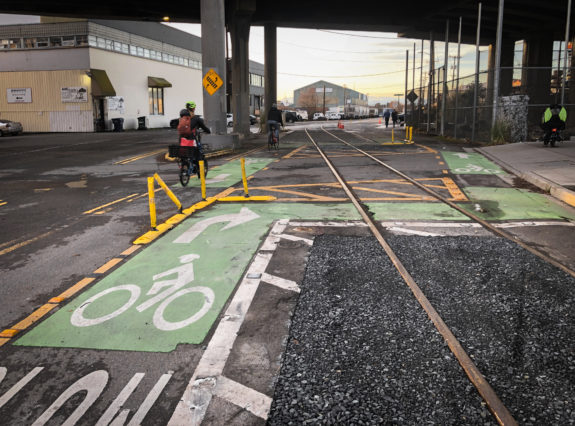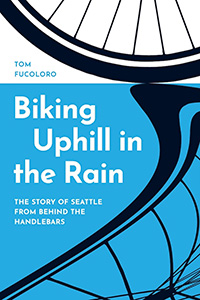
Despite reaching a settlement with a group of eight people who sued the City of Seattle in 2022 after they crashed and were injured while biking through the Ballard Missing Link, the city still has not made the treacherous railroad crossing under the Ballard Bridge “reasonably safe for ordinary travel,” according to a new set of claims from 10 additional people injured while biking there.
The new claims are a potential precursor to a lawsuit and were filed by the firms Washington Bike Law and Schroeter, Goldmark & Bender (Full disclosure: Washington Bike Law advertises on Seattle Bike Blog). For decades, people have been crashing while biking on these tracks that cross the poorly-maintained roadway near and directly under the Ballard Bridge. As part of a 2022 settlement, the city agreed to make design changes to the track crossing. However, the first phase of changes were widely panned, including by Seattle Bike Blog, for adding new potentially dangerous gravel pits that seem to be “baffling riders rather than helping them.” A second phase of changes is planned that will hopefully create a safer and more usable track crossing, and the press release from WBL and SGB notes that the city has until December 31 to complete this phase or the previous riders will be able to file another suit.

It’s frustrating that fixing this long-known problem area is requiring lawsuits and binding legal agreements, but that’s where we are. And unfortunately, there is surely a depressingly long list of potential litigants who have x-rays and bloody photos to show the court. When Seattle Bike Blog asked SDOT in January for a timeline on phase two of work, a department spokesperson said, “We have not scheduled this work yet. We will likely schedule this in the near term, but the exact date will depend on weather conditions, crew availability, and if other unexpected high-priority safety needs arise.” It is August now and the summer has been quite dry, so I guess something else was more important.
All of this would have been a moot point long ago if a handful of businesses had not sued to stop the city from completing the Burke-Gilman Trail, the fully complete and ready-to-build design of which includes an improved rail crossing. But the city continues to rack up legal losses delaying the permits they need to build the trail, and they need to make this most dangerous part of the Missing Link area safe in the meantime. It’s simply not OK to allow such a known hazard to continue existing for this long. Everyone’s patience on this particular issue ran out a long time ago. Fix your goddamn street, Seattle.
The press release from WBL and SGB:
Ten people injured in bicycle crashes on the “Missing Link” of the Burke-Gilman Trail recently filed claims against the City of Seattle for its failure to make the existing roadway reasonably safe for ordinary travel, according to attorneys representing the individuals. The ten riders suffered varying degrees of injury ranging from contusions to broken bones to traumatic brain injury.
Washington Bike Law (WBL) and Schroeter Goldmark & Bender (SGB) are Seattle law firms cooperatively representing the bicyclists. “The aim of the claim notices filed today is not simply to achieve compensation for our clients’ injuries, but to prompt action by the City to prevent more people from being seriously injured by this known danger,” said SGB attorney Adam Berger.
The Missing Link is a 1.4-mile stretch in Seattle’s Ballard neighborhood where the Burke-Gilman Trail abruptly ends, sending bicyclists onto streets that are still not reasonably safe for travel by bicycle. The ten bicyclists were all injured where many others have crashed before them: the Missing Link’s “Crash Zone,” a dangerous railroad crossing under the Ballard Bridge.
WBL’s Bob Anderton has represented multiple bicyclists injured in this same Crash Zone dating as far back as 2001. During the pendency of the 2001 case, the City refused to resolve these claims out of court and in 2004 Anderton obtained a verdict against the City. “Sadly, two decades later, people are still regularly crashing on the same railroad tracks and, despite many plans and compromises to complete the Burke-Gilman Trail and mitigate this known danger, the Missing Link remains dangerous, and the Burke-Gilman Trail remains incomplete,” Anderton said.
Because the area was still not reasonably safe for ordinary travel, in 2021 WBL again began representing some of the many people who continued to crash on these tracks. After filing a lawsuit and litigating in both state and federal courts, WBL, joined by SGB in 2022, obtained monetary settlements for all of their clients who were injured on the Missing Link.
In addition to compensation for their individual clients, WBL and SGB negotiated a separate settlement agreement, with the clients’ permission, to benefit the entire community.
Under that settlement, the City of Seattle agreed to take specific actions on the Missing Link by certain dates. WBL and SGB negotiated this agreement with the hope that the area would finally become reasonably safe for ordinary travel by bicycle.
Kathleen Nolan, a retired nurse, was one of the WBL and SGB clients who authorized the agreement with the City of Seattle. Ms. Nolan fractured her femur when she crashed on the Missing Link in 2020.
Ms. Nolan’s husband, Doug Kelbaugh, a 77-year-old celebrated architect who chaired the Department of Architecture at the University of Washington and pioneered a national passive solar energy movement, was one of the people in the ten recent claims.
On July 30, 2022, Mr. Kelbaugh was riding west on the Burke-Gilman Trail and encountered the Missing Link. As he followed the City’s marked bicycle lane through the Crash Zone and attempted to cross the railroad tracks, he crashed. Despite wearing a helmet, Mr. Kelbaugh suffered a traumatic brain injury and required emergency surgery at Harborview Medical Center to relieve bleeding in his brain.
Although the City completed the first phase of work under the settlement, the Crash Zone continues to be unsafe.












Comments
8 responses to “10 more people file claims against city over Ballard Missing Link injuries”
Only a non cyclist could conceive of cycling route that requires negotiating turns that have such a ludicrously small radius of curvature. Tricky to negotiate even for people who are paying attention and have slowed down enough to take the turns. For those riders who tend to travel at higher speeds (I’m thinking specifically of some e-bike riders), there is a good chance they will end up drifting over into oncoming traffic as a result. This actually already happens quite a lot on the Westlake trail.
What about reducing the severity of the curves and having the path cross the tracks at an angle. Then, design and build a removable track cover that lag bolts to the street. When the train needs to use that section of track the cover can be removed, then bolted back in place after the train has passed.
The really sad thing about this is there is no economic reason why these railroad tracks need to be there at all. They don’t go anywhere, they’re in decrepit shape, and don’t connect to any other tracks.
It’s essentially a defunct railroad company taking advantage of arcane railroad laws from the 1800’s to cling to the land, hoping its land value appreciates.
I was wondering about that too. So they’re an officially useless safety hazard. I wonder if a lawsuit could compel them to remove the rails or somehow improve the safety.
Ask yourself this, why does Seattle still allow the operation of some ancient 1940’s diesel engine that spews a titanic amount of pollution when fired up and running?
You can track air pollution in that area, especially during periods of the winter when the county bans the burning of other less polluting sources.
At this moment? Looking at PurpleAir you can see that the area of where the train is being operated is at an AQI level of 153 vs the ~25 AQI of surrounding areas. If you track the numbers you can see this a modest level of pollution often generated by that antique.
I’m a bit ambivalent about this. Especially this stretch of road. It is a quiet stretch of road to bike on and has a bike lane.
On the one hand it will require sdot to keep paying serious attention to bike infrastructure. On the other hand: there are so many projects (especially in the south) being delayed by SDOT because of funding and staffing shortages and here we go again focus attention on a part of the city that has relatively good bike infrastructure.
Just try to bike anywhere south of the I90. And compare this stretch that they are suing over and what you would encounter there.
And to be clear I will also cheer the moment the missing link is finally completed.
I assume that the city hired a consultant to design this solution. Has the city ever considered hiring a Dutch firm to design bike infrastructure? As illustrated by this design, the city and its consultants are incapable of designing a safe solution. I think North American firms lack the expertise, experience and imagination.
My understanding is that the railroad (Ballard Terminal Railroad) takes deliveries to Salmon Bay Sand and Gravel. Because 19th century laws are quite generous to railroads, it’s hard to get them to move.
off-topic: two examples of unused rails: 14th Avenue NW at NW Leary Way and the former George Benson Waterfront Streetcar line on South Main Street between 1st and 5th avenues South.
The Ballard line once served Bardahl was in use into the early 1960s. I am sure there have been accidents on 14th Avenue NW. The track is diagonal just north of Leary.
SDOT took out the platform from South Main Street but left the track in place.